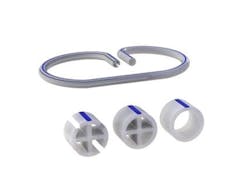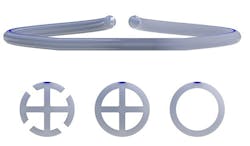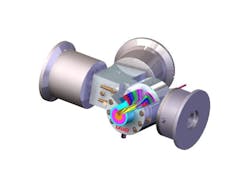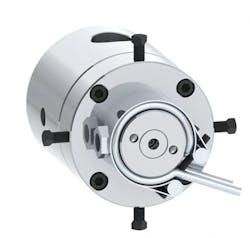Extrusion Takes Some New Turns: Better Design Options in Inline Tubing Dies
At a Glance:
- Guill Tool & Engineering has developed a reciprocal tubing die design. Unique features eliminate the need to weld or otherwise join sections with different profiles together.
- Traditional tip-and-die assembly is replaced with a linear reciprocating assembly that changes the tube’s profile within a given length.
- An outline of key features and benefits of the Guill Series 800 and Series 900 inline tubing dies.
Technology in the medical devices field is constantly evolving and often requires an extensive array of medical-grade tubing in a variety of materials and thicknesses. Guill Tool & Engineering designs and manufactures custom extrusion tooling for medical tubing and other products.
Guill Tool & Engineering’s micro medical tooling, for instance, can extrude tube thinner than a human hair, .008 in. or finer per revolution, and can be used to keep procedures as non-invasive as possible. Other models are used to produce tubing for feeding applications, including nasogastric and jejunal tubes.
The company has achieved a series of successes in the areas of multi-layer dies and, most recently, a reciprocal tubing die for wound draining that reconfigures the internal chambers of the tubing to accommodate drainage.
Drain tubes can be inserted prophylactically to prevent or remove the accumulation of fluid in a wound. Alternatively, such tubing can also be therapeutically inserted to evacuate an existing collection of fluid in a wound. Fluid is removed in order to treat or prevent infection and promote wound healing and patient comfort. Drain tubes can also be used to diagnose post-operative complications such as an anastomotic leak or hemorrhage. The Guill Tool design has unique features that eliminate the need to weld or otherwise join sections with different profiles together.
READ MORE: Designing a Better Rubber/Silicone Extrusion Crosshead
“Our automated extrusion process drastically changes the extruded profile in production, with no need to join separate sections of internal profiles,” said Tom Baldock, sales manager, Guill Tool & Engineering.
A Reciprocal Tubing Die Featuring Linear Reciprocating Assembly
Guill Tool, which is based in West Warwick, R.I., has engineered this new reciprocal tubing die with various features unique to the product. The traditional tip-and-die assembly is replaced with a linear reciprocating assembly that changes the tube’s profile within a given length. This process is repeated throughout a single extrusion run without interruption. Cutting capability, in association with the extrusion speed, cuts the finished product to length.
While cost and value stream activities are reduced, quality is actually improved. Only one extrusion run is needed to produce a finished product, as opposed to multiple extrusion runs with tooling changes along with a manual assembly operation to connect different tubing shapes via sonic welds or other methods of joining. Guill’s new reciprocating head eliminates this entire assembly operation. It also eliminates in-process inventory. Thus, there is no need for storage of various tubing shapes and connectors needed for assembly, fulfillment of orders and replenishment of finished goods.
Furthermore, the reciprocating head eliminates a connecting piece, allows JIT production and products made-to-order. Lastly, it reduces total run time from receiving the order to shipping the product.
In the multi-layer extrusion arena, a primary focus of Guill Tool over the years, the company has also introduced the latest generation of its Series 800, the 2-to-6 layer extrusion tooling designed to produce the highest quality, highest material-efficient 1/8 in. to 6 in. OD tubing for medical and surgical applications. The redesigned Series 800 produces flawlessly smooth extrusion and layer definition of Fluoropolymer and other materials for all multi-layer, multi-lumen medical tubing. The design further allows thin layer combinations of polymers and adhesives to .02mm or less.
Guill offers its extensive line of crossheads and inline tubing dies in fixed and adjustable centers, for single or co-extrusion applications. The tooling is designed to process all compounds and features the company’s patented, precision Feather Touch Concentricity adjustment, the Seal Right System, which combines with the Feather Touch system to eliminate polymer leaking. The company also offers its unique spiral flow distribution system.
Guill tooling is produced with rigorous computer simulation of the flow channels using Computational Fluid Dynamics (CFD) programs, resulting in optimum uniform flow with no weld lines.
New Series of Inline Tubing Dies for Hose and Pipe Offers Improved Extrusion Performance
Guill Tool’s new Series 900 of inline tubing dies offers improved extrusion performance and capabilities to customize at standard, off-the-shelf prices. The new series is applicable to extrusion of hose or pipe ranging from 0.005 in. (0.127mm) to 8.0 in. (635mm) in diameter for all types of OEM, food service, automotive, industrial, telecom and medical applications in polymer or rubber.
The Series 900 technology offers the following benefits:
- Achieves concentricity or “product roundness” which greatly reduces material usage compared with other types of extrusion tooling
- Spiderless inline-designed heads results in no spider lines and allows room for more air—thus eliminating cold legs, which can inhibit product output
- Runs 1-5 layers simultaneously
- Engineered for a multitude of applications—including special fluoropolymer applications
A key technical highlight of the Series 900 is a patent-pending FeatherTouch adjustment in the die holder and a cartridge-style ball assembly that does not require the loosening of retaining screws to make adjustments. Additional unique benefits of the Series 900 include Guill’s Seal Right Systems, a positive seal, which eliminates leakage between deflectors, along with easy self-alignment that reduces operator error during assembly and is adaptable to a variety of specific extruder layout configurations.
READ MORE: High-Risk, High-Reward: Investing in Game-Changing Plastics Extrusion Technology
“This series offers a standard platform design of the head with specific characteristics that are unique to individual applications included at no additional charge in the cost of the tooling,” said Baldock. “This is a tremendous benefit to a company that requires precision tooling with custom benefits at a standard off-the-shelf price. That certainly helps our customers’ bottom line,” said Tom Baldock, Guill sales manager.
Guill Tool also manufactures tips, dies and breaker plates using state-of-the-art computerized CNC machining and EDM equipment. As well, engineering services using the latest CAD systems are available for custom-designing extrusion tooling products such as crossheads, tips, clamps, flanges, forming rolls, spiderless inline dies, dies, swing gates, breaker plates, special equipment and sizing dies.
Guill Tool received ISO certification in 1995. The first major extrusion tooling company to meet international standards, Guill Tool has long been recognized as one of the leading established designers and manufacturers of custom extrusion tooling for applications including wire, cable, fiber optics, medical tubing, wood composites, automotive tube, plastic compounding, custom applications, rubber, profile, industrial pipe, hose/tube, blow molding, and food and packaging.
Founded in Rhode Island in 1962 by A. Roger Guillemette, Guill Tool was established as a job shop supplying tips, dies, crossheads and replacement parts to the wire, cable or wire and cable, plastic and rubber industries in New England. Later, Guill Tool became a supplier for the entire United States and Canada and today enjoys a worldwide market presence.
Technology in the medical field is constantly evolving and often requires an extensive array of medical-grade tubing in a variety of materials and thicknesses. Guill specializes in working with clients to design and manufacture Custom Extrusion Tooling to produce an unparalleled range of the highest quality medical tubing in the industry. The company’s Micro Medical tooling can extrude tube thinner than a human hair, .008 in. or finer per revolution, and can be used to keep procedures as non-invasive as possible. Other models are used to produce tubing for feeding applications, including nasogastric and jejunal tubes.





